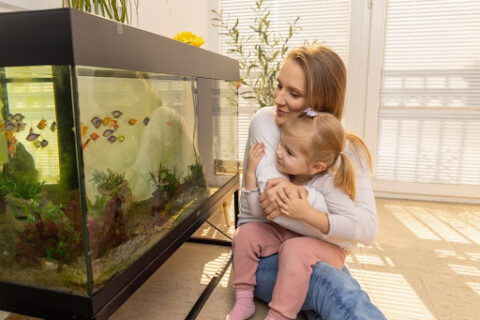Knowing how to transport koi is not second nature to most people. However, you should know it is possible to transfer your koi from one pond to another without negatively impacting them. All it takes is some knowledge of the potential risks and the proper moving techniques. That’s why we put together a guide on how to move your fish:
Don’t Ditch Your Fish: Why You Should Move Your Koi
It’s undeniable, a koi pond adds a touch of elegance and tranquility to your backyard. But the magic of koi ponds extends far beyond aesthetics. Here are just a few reasons why having a koi pond can enrich your life:
- Stress Reduction: Studies have shown that the gentle glide of koi and the calming sound of water features can significantly reduce stress levels and lower blood pressure. Spending time by your pond can be a daily dose of serenity.
- A Touch of Zen: Koi are revered for their peacefulness in Japanese culture. Watching their graceful movements can be a form of meditation, promoting mindfulness and a sense of calm.
- Boost for Wildlife: Your koi pond can become a vibrant little ecosystem, attracting butterflies, birds, and even frogs. This not only adds to the beauty of your space but also supports local biodiversity.
- A Family Activity: Koi care can be a fun and educational activity for the whole family. From feeding the fish to learning about water quality, it fosters responsibility and connection with nature.
- Increased Home Value: A well-maintained koi pond is a desirable feature for many homebuyers, potentially boosting your property value.

What are the Risks of Moving Koi Fish?
Since koi fish are expensive and sentimental, you want to protect your investment the best you can. If you’re looking for ways to move fish, it’s important to know the dangers first. Be aware of these common risks before you make your move:
1. Koi Fish Can Get Stressed
Koi fish often get stressed when their environments change. Although you can’t do much about the change in environment, you should take a few precautions (which we will cover below) to prevent your koi from feeling threatened.
Stress can lower your koi’s immune response, potentially making it harder for them to fight off illnesses and infections during relocation. Other health problems can also arise from stress, and you may not notice the symptoms for days or weeks after the move. That is why you should do your best to minimize stress as much as possible (see tips for transporting koi carp below).
2. Injury Can Occur
If you treat your koi roughly during the move or expose them to harsh environments, they could get hurt. For example, if you quickly lift your koi out of their pond with a net or shake them too much, they could lose some of their protective slime. This slime protects them from parasites, infections and other maladies.
3. The Koi Fish Could Die
Death is the most serious risk of transporting your koi. If they don’t have access to enough oxygen, their water becomes too dirty or they get sick, your koi could die during the move. Fortunately, you can avoid this fate with the proper moving process. Let’s dive into some tips on transferring your fish from one pond to another:
Tips on How to Transport Your Koi Fish
With careful technique, you can successfully move your koi to their new home. Here’s how to transfer your fish:
1. Net Your Koi Carefully
Invest in a quality koi net and use it to carefully coax your fish into your chosen container. Don’t chase your koi around the pond, instead, place it behind them or slightly under them to help guide them into their transportation bag or bin.

2. Move the Koi in a Proper Container
You can move koi in plastic bags as long as you also have a rigid container to put the bags in. If you choose plastic bags, you’ll also want some rubber bands to close up the tops. Make sure you have enough bags to double bag the koi fish. You can also skip the bag entirely and put your fish directly into a rigid container (like a plastic bin, for example).
3. Use their Original Koi Fish Pond Water
The water in your koi’s transportation container should be as close to their normal pond water as possible. In fact, you can just use water directly from their pond. If you want or need to use different water, make sure its pH and temperature are the same as their original pond. The water should match within .3 on the pH scale and 4°F of its original temperature.

4. Add Salt to the Koi’s Water
Finally, your fish will experience less shock and stress if you add salt to their water. The kind of salt does not matter, just use 3 grams per liter of water. You can also add things like a water conditioner or slime coat product to help your fish maintain their coatings.
Make Your Move Go Swimmingly with Bekins Van Lines
Now that you know how to transport koi, it’s time to get started with your move! Whether you’re moving down the street or moving long distance you don’t have to leave your fish behind. Use the tips above to keep your koi safe during your relocation. Then, to make your move even easier, move with Bekins. We can get you, your family and your fish to your new space quickly and efficiently. Get an in-home estimate!

